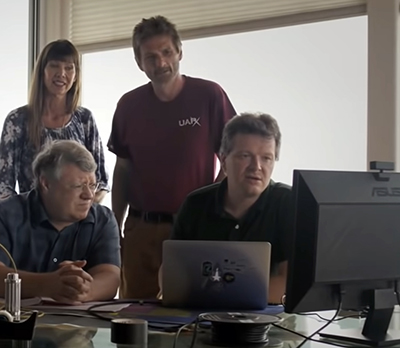Physicists Star with William Shatner in New UFO Documentary
ALBANY, N.Y. (Aug. 23, 2022) — A new documentary starring Star Trek’s William Shatner is asking the question: “Are we Alone?” And two UAlbany physicists are right in the middle of the search for answers.
“A Tear in the Sky,” a documentary directed by Caroline Cory, will be screened at 7 p.m. in Page Hall on Friday, Aug. 26. In it a team of researchers utilizes state-of-the-art technologies to study Unidentified Aerial Phenomena (UAP). The acronym, an update to what has been more commonly referred to as Unidentified Flying Objects (or UFOs), refers to a host of unexplained images and sightings that have occurred for generations, but with renewed intent to detect, analyze and catalog findings in a scientific manner.
The team includes associate professors of physics Matthew Szydagis and Kevin Knuth.
In the documentary, a team of military personnel, scientists and Shatner attempt to capture, over the course of five days, evidence of U.S. Navy "Tic Tac" UFOs and other potential anomalies.

“The variety of devices we’re bringing as a team to study the phenomenon cover an entire spectrum of different technologies, in real time,” said Szydagis in the documentary.
A subject that is generating considerable mainstream interest since the release of previously classified U.S. government videos and the creation by the Pentagon of a UAP Task Force in August 2020, the film also features celebrity physicist Michio Kaku.
Following the screening, Knuth and Szydagis will take part in a Q&A session.
Knuth, who recently served as associate chair of the Department of Physics, is editor-in-chief of the journal Entropy (MDPI). He is a former NASA research scientist having worked for four years at NASA's Ames Research Center in the Intelligent Systems Division, designing artificial intelligence algorithms for astrophysical data analysis.
Szydagis specializes in experimental particle astrophysics. He is the developer of important new tools in his field, including the NEST (Noble Element Simulation Technique) software and the “snowball chamber” supercooled water technology along with his colleague, Assistant Professor of Physics Cecilia Levy (now also a part of the UAP-seeking effort). Szydagis and Levy are also a part of the LUX-ZEPLIN experiment, the most sensitive dark matter detection project in the world.




